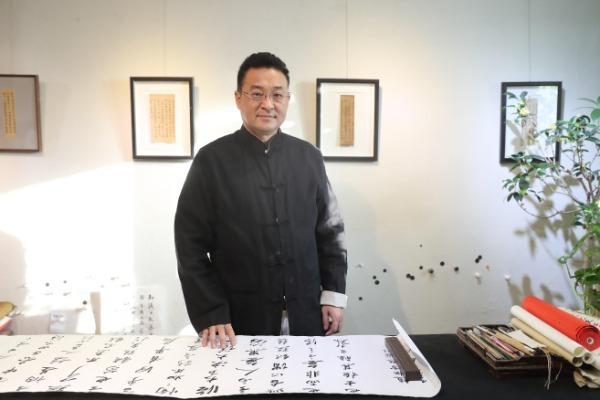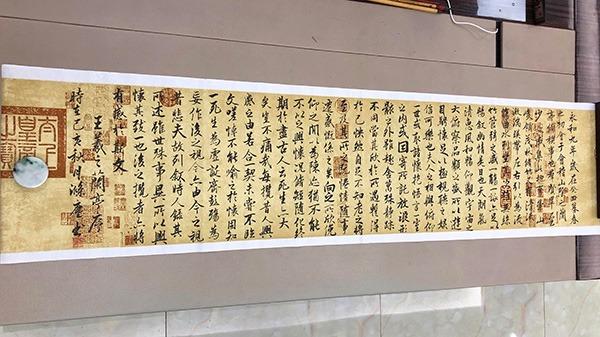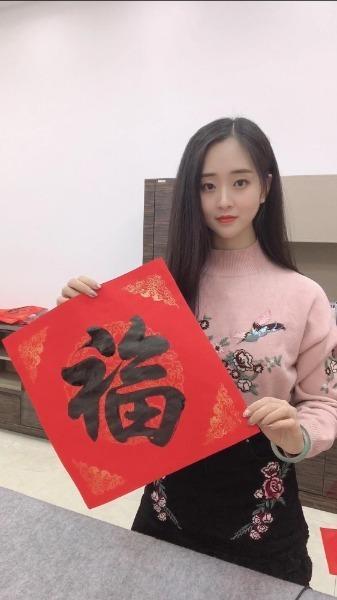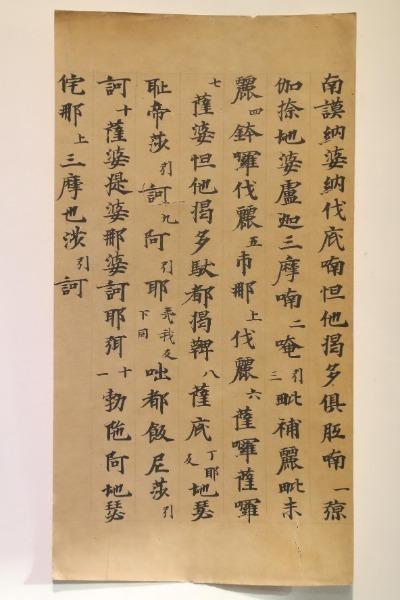 Xu Kangyan practices the art of handwriting every day in his study in Beijing. He tutors more than 60 adult students from all walks of life to learn Chinese calligraphy.( WANG JING / CHINA DAILY)
Xu Kangyan practices the art of handwriting every day in his study in Beijing. He tutors more than 60 adult students from all walks of life to learn Chinese calligraphy.( WANG JING / CHINA DAILY)
A character-forming display of elegance and style has seen Wu Dichen, 29, garner more than 1 million fans as her soft smile belies the depth of her expertise and her exquisite style.
Wu has won over numerous fans on Chinese social media platforms since she released her first video on sharing platform TikTok in May 2018
Wu has won over numerous fans on Chinese social media platforms since she released her first video on sharing platform TikTok in May 2018. But in this case the modern technology is used to highlight a traditional skill far from the usual fare of cooking, singing or plain publicity seeking. Wu's fame is due to her delicate and fascinating writing of Chinese characters.
One of the videos Wu released on the platform in December 2018 saw the number of her fans surge by about 60,000 overnight as she brought the ancient craft to a new generation of admirers.
"She is pretty. Her handwriting technique and style are beautiful too," said a fan commenting on Wu's video. Another fan said: "I rely too much on my mobile phone and I often forget how to write (Chinese characters). Her videos encourage me to write again."
Wu is delighted that her videos have inspired more young Chinese people to pick up the brush to learn calligraphy.
 A work by Wu Dichen, a copy of the famous piece Lanting Xu (Preface to the Poems Composed at the Orchid Pavilion) made by Wang Xizhi during the Eastern Jin Dynasty (317-420). (PHOTO PROVIDED TO CHINA DAILY)
A work by Wu Dichen, a copy of the famous piece Lanting Xu (Preface to the Poems Composed at the Orchid Pavilion) made by Wang Xizhi during the Eastern Jin Dynasty (317-420). (PHOTO PROVIDED TO CHINA DAILY)
"I didn't expect that my videos would have received so much attention and that afterward the viewers were more interested in calligraphy, an important ancient Chinese art form," says Wu in a phone interview with China Daily. "Chinese characters carry on Chinese culture and history."
Wu was born and raised in Gaotang county, Liaocheng city in Shandong province, which is also home to Li Kuchan (1899-1983), a famous Chinese painter, calligrapher and art educator. Gaotang county is renowned as a center of art and calligraphy.
 Wu Dichen, a Chinese calligraphy enthusiast. (PHOTO PROVIDED TO CHINA DAILY)
Wu Dichen, a Chinese calligraphy enthusiast. (PHOTO PROVIDED TO CHINA DAILY)
Wu's grandparents were both teachers and her grandfather practiced calligraphy at home. This inspired Wu to learn the art as a child. She had a close bond with her grandfather, she says, who suggested her name at birth. Dichen literally means washing away the dust, to have a "pure soul". Wu recalls that during childhood she loved playing a writing game with her fingers in the air, mimicking the style and strokes of Chinese characters she saw on the streets and on TV.
About four years ago, Wu attended a calligraphy class, catering to adult learners. She learned how to write in the style of xingshu (running script) and kaishu (regular script). Wu, who worked in a local internet company, practiced calligraphy for about four hours every day after work.
"The process of writing helps me to focus my thoughts and relax my mind. Usually I write Chinese poems, which is a great way to learn about traditional culture.""The more I practiced, the more I loved calligraphy," Wu says. Besides using ink and brush, Wu also uses a pen to write.
Unlike many of her peers, who are "addicted" to their mobile phones for playing video games or watching TV shows, Wu is self-disciplined and focuses on her calligraphic writing. She also loves reading books about calligraphy and drawing with colored pencils.
She has created more than 1,000 calligraphic works. Some followers pay her to write Chinese characters, and through this she earns about 30,000 yuan (US$4,363) every month. However, Wu has not decided to take the art form as a full-time career.
With Spring Festival around the corner, Wu has written hundreds of chunlian, or spring couplets, two lines of poetry which usually express best wishes for the coming year. She writes them mainly for her fans, family and friends.
"All my spare time is taken up with handwriting. I am still learning and practicing. Since I started to learn calligraphy, I have been introduced to the world of Chinese culture, which I am fascinated with. I hope more young people will become interested in it after watching my videos," Wu says.
One of the best known Chinese calligraphers is Wang Xizhi of the Eastern Jin Dynasty (317-420), who wrote kaishu, xingshu as well as caoshu (cursive script). Many Chinese calligraphers imitated his style, but no one ever bettered him for artistic transformation. One of his most famous works is Lanting Xu (Preface to the Poems Composed at the Orchid Pavilion), considered one of the best-known calligraphic works in Chinese history.
"It is true that calligraphy belongs to ancient times since we no longer use the ink and brush as writing tools. However, calligraphy is part of traditional Chinese aesthetics and philosophy," says calligrapher Xu Kangyan, 52, who learned the art as a child with his uncle.
Living in Beijing, Xu has been researching Wang's calligraphy for more than two decades and has been teaching young people calligraphy classes since 2010.
 A work from Xu's collection, a piece of Buddhist scripture written in Tang Dynasty (618-907). (WANG JING / CHINA DAILY)
A work from Xu's collection, a piece of Buddhist scripture written in Tang Dynasty (618-907). (WANG JING / CHINA DAILY)
"Learning calligraphy requires an in-depth knowledge about its cultural background, which cannot be gained overnight," says Xu, adding that in Chinese, calligraphy is shufa, with shu meaning "writing" while fa meaning "the laws" or "methods".
ALSO READ: Cyberstars shine
"The way of holding your brush, moving your arm and hand, and arranging the strokes, all are based on rules, which take time to practice," says Xu.
Speaking of his own experience of learning and practicing calligraphy, Xu says that he feels at peace once he dips his brush into the ink.
"Each character you write reflects your mood at that moment. It also shows your personality and aesthetic," says Xu, who has more than 60 students from all walks of life, ranging from college students to retirees.
In ancient China, youngsters started compulsory, extensive training in calligraphy with ink, brush and paper even before they reached their teens. Today, with ubiquitous modern technology, few write with a pen, let alone calligraphically. But there are signs that the discipline is attracting a new generation of fans.
READ MORE: Exhibition shows how a modern master let nature nurture his art
In his hometown, Haicheng, Liaoning province, Xu says, there are more than 100 calligraphy training centers. "Our small city has only about 2 million people, but young people learning calligraphy has become a growing phenomenon in society," Xu says.


